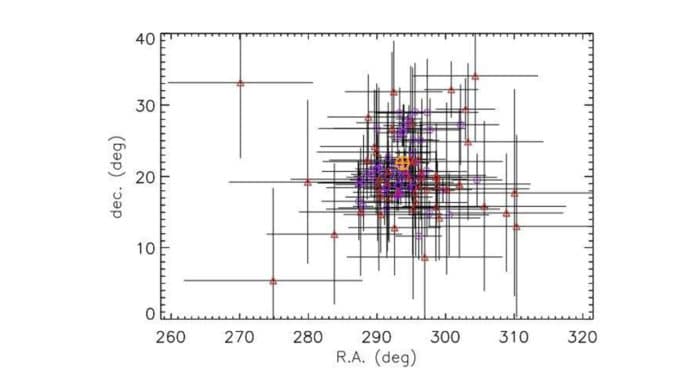Magnetars comprise a group of isolated neutron stars with powerful magnetic fields, which fully determine the emission properties of these systems. They slow down rapidly, likely under the influence of large magnetic torques.
Originally discovered in 2014, the magnetar SGR J1935+2154 has a rotational period of 6.67 hrs, spin period of 3.24 seconds, spin-down rate of 14.3 picoseconds/second, and a dipole-magnetic field with strength at a level of approximately 220 trillion G, what confirms its magnetar nature. Since its discovery, the magnetar has experienced more than 100 bursts, occurring almost annually.
Now, using NASA’s Fermi and Swift spacecraft, a team of astronomers led by Lin Lin of Beijing Normal University, China has studied SGR J1935+2154, the most recurring transient magnetar known to date. Their investigation has shed more light on the burst properties of this object.
Astronomers mainly focused on 127 short bursts that took place between 2014 and 2016.
They found that 97 percent of the observed bursts occurred during four active burst episodes, which makes SGR J1935+2154 the most prolific magnetar transient to date.
Astronomers noted, “the total energy fluence emitted in their burst sample is 0.000062 erg/cm2, which corresponds to 1.5 duodecillion erg if the estimated distance to SGR J1935+2154 (approximately 29,300 light-years) is true.”
“The persistent X-ray flux increase of SGRJ1935+2154 is modest at the onset of each outburst, and its value changed by factors of five to 10. This is much lower than the value in most transient magnetars, as they usually showcase X-ray flux increases at a level of between 50 and 100 at the activation onset.”
“The majority of bursts in the 2014 and 2015 active episodes took place on the first day of the episode, before subsequently decaying over 100 days.”
“Two episodes in 2016 commenced with two or three bursts and that two outbursts that year were brighter at the onset than those in 2014 and 2015, quickly decaying to the quiescent level.”
“This connection between bursts and outbursts strongly indicates that the total energy released in short bursts accelerated the fading of the persistent outburst (at least one component of the persistent emission).”
Journal Reference:
- Burst properties of the most recurring transient magnetar SGR J1935+2154. arXiv:2003.10582
